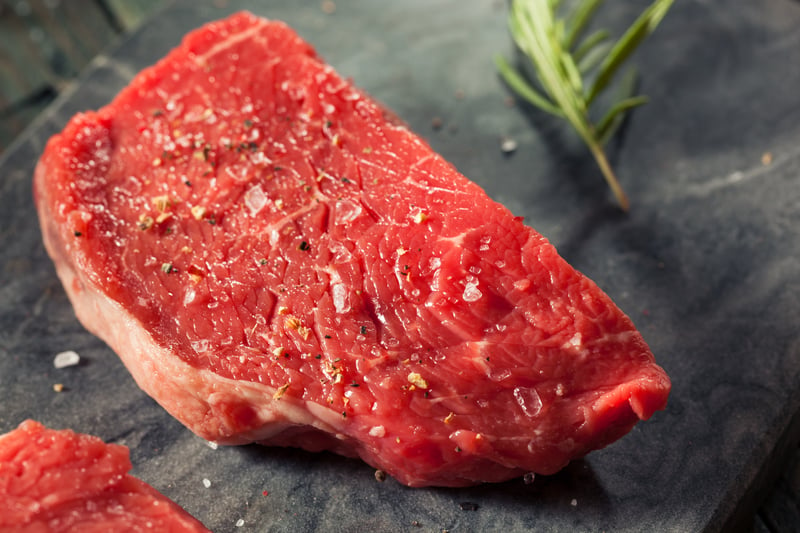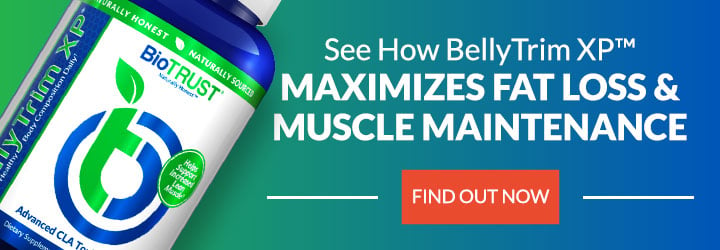Here are 8 Powerful Health Benefits of Grass-Fed Meat

As the old saying goes, “You are what you eat.” Well, that saying doesn’t start and stop with humans. It applies to all species that make up the food chain. What it eats affects its composition. Take fish, for example. Algae are the primary producers of the omega-3 fats DHA and EPA in the food chain. Wild fish that consume algae are, not surprisingly, rich sources of these healthy fats. Conversely, farmed fish that are fed corn- and/or soy-based diets contain a lower percentage of omega-3s. They also have a higher concentration of omega-6 fats.2 (More on this in a moment… foreshadowing.). The same points can be made for grass-fed meat.
Well, as you might expect, there are key differences between animals fed a grass-based diet versus those on a largely grain-based diet (e.g., soy, corn). Let’s talk about some of these benefits.
8 Health Benefits of Grass-Fed Meat
More Omega-3 Fats
Perhaps the most highly touted benefit of grass-fed meat is that it’s higher in omega-3 fats. These fats are well-known and highly-regarded for their wide range of beneficial effects on heart health, mood, brain health, immune function, skin health, metabolic function, and more. Studies estimate grass-fed beef may be upwards of 5 times higher in omega-3 fats compared to meat from grain-fed animals.3
These bad boys are so important that the American Heart Association recommends adults consume a minimum of 500 mg/day of EPA and DHA. Often, more is better. The unfortunate reality is the average person consumes only about a quarter of that amount (around 135 mg/day).4,5 And because we must get these essential fats through our diets (via food and/or supplements), making sure we’re eating plenty of omega-3-rich foods is critical for overall health.
Better Ratio of Omega-6 to Omega-3 Fats
Studies over the last decade or so have highlighted the significance of the ratio of omega-6 to omega-3 fats consumed. A healthy diet should consist of an estimated 2 – 3 times more omega-6 fatty acids compared to omega-3 fatty acids. The typical American diet, however, tends to contain a whopping 15 – 30 times more pro-inflammatory omega-6 fats. This phenomenal swing has been blamed for an increase in virtually all inflammatory disorders.6
Overconsumption of processed foods—which are packed with pro-inflammatory, omega-6-rich refined seed oils—certainly plays a substantial role. Yet, the consumption of foods from farm animals raised on grains rich in omega-6 fats (e.g., corn, soy) no doubt contributes as well.7,8 Grass-fed meat contains, on average, about a 1.5:1 ratio of omega-6 to omega-3 fats. Meanwhile, grain-fed meat typically provides 7.5 times more omega-6 fats compared to the anti-inflammatory omega-3s.
To borrow a phrase from G.I. Joe®, getting plenty of omega-3s in the diet is only half the battle. The other half is being mindful of—and often, reducing—our intake of omega-6s.
More Conjugated Linoleic Acid
Perhaps the most striking difference between grass- and grain-fed meat is the content of conjugated linoleic acid (CLA). This special category of dietary fat is responsible for a variety of health benefits. Dietary CLA is found only in the meat and milk from ruminant animals (e.g., cows). And grass-fed beef contains substantially more (as much as 3 times more) compared to grain-fed meat.3
Among the numerous benefits of CLA is improved body composition. Research has shown CLA has the potential to reduce body fat and increase lean muscle.9,10 And while those are the most publicized benefits (which are associated with supplemental doses of CLA), CLA has quite a bit more to offer. For instance, CLA possesses antioxidant activity, it enhances immunity, and it helps promote a healthy inflammatory response.11
More Micronutrients and Antioxidants
In addition to its healthier fat profile, grass-fed meat also packages higher amounts of the key antioxidants β-carotene and vitamin E. These help fight free radicals, support immune function, and protect the body from oxidative stress. In addition, grass-fed meat is higher in certain B vitamins like riboflavin and thiamin. And it’s higher in key minerals including calcium, magnesium, and potassium.3,12
On top of that, grass-fed meat has been shown to be higher in glutathione. Commonly referred to as the body’s “master antioxidant,” glutathione plays a crucial role in reducing free radicals. This protects body cells from excessive age-accelerating oxidative stress. Glutathione is also important for immune function. And, it’s a natural detoxifier, helping eliminate potentially harmful toxins.

No Growth Hormones or Antibiotics
According to the American Grassfed Association’s (AGA) Grassfed Standards for meat and dairy, grass-fed animals are never treated with antiobiotics or growth hormones. The AGA cites the fact that Europe has banned the import of American beef raised using hormones, steroids, or antibiotics. According to the AGA, “In our opinion, there are NO ‘safe’ hormone, steroid, or antibiotic residues for families to consume in beef.”
And we, at BioTrust, would agree. In addition to unnecessary animal suffering, treatment with artificial growth hormones and steroids may result in an increase in the IGF-1 content of meat and milk. There’s also some evidence that suggests a potential link between IGF-1 levels and certain cancers. What’s more, the use of growth hormones typically amplifies the use of antibiotics. Speaking of which…
Less Exposure to Harmful Bacteria
The use of antibiotics can lead to the development of antibiotic-resistant bacteria (e.g., Staphylococcus aureus). These bacteria have been linked to a range of health problems from rashes to respiratory infections to potentially fatal illnesses.13 According to research published by Consumer Reports, grain-fed beef was much more likely to contain the “superbug” MRSA (methicillin-resistant Staphylococcus aureus). MRSA alone killed over 11,000 people in 2011 in America.
Overall, 18% of conventional beef samples were contaminated with antibiotic-resistant bacteria. “We know sustainable methods are better for the environment and more humane to animals. But our tests show that these methods can produce beef that poses fewer public health risks,” according to Urvashi Rangan, PhD, executive director of the Center for Food Safety and Sustainability at Consumer Reports.14
Sustainability
Industrial food production is a significant threat to the environment. Due to greenhouse gas emissions and land and water use, meat production is arguably responsible for the largest impact. Reducing meat consumption (and replacing it with plant-based foods) has the potential to promote the health of the planet. Yet sustainable eating practices can also have positive effects.
Choosing meat (and other animal-derived products) from grass-fed, pasture-raised animals is ideal. The higher quality grass-fed meat is more nutrient-dense, providing more omega-3 fatty acids and antioxidants. What’s more, this choice means fewer agricultural chemicals and antibiotic residues.15
Animal Welfare and the Difference Between Grass Fed vs Grass Finished
Before closing up shop, it’s important to distinguish between “grass-fed” and “grass-finished” meat. According to the AGA, virtually every cattle in the United States is grass-fed at some point during its lifetime. However, many cattle, especially during the finishing stage (the last 90 days), are grain or corn fed. These cattle would not truly qualify as grass fed.
“If cattle are NOT raised on grass and finished on grass pastures, eating entirely natural forage and grass, most of the health benefits from grass-fed beef are totally destroyed,” says former AGA president Dr. Patricia Whisnant. The majority of cattle indeed start out on grass but are “finished” on feedlots.
Feedlots are designed to pack thousands of cows into a crammed area to put on the greatest gain in the shortest amount of time. All in an effort to gain the greatest profit. Meat from feedlot animals is NOT truly grass-fed beef. Feedlot animals are grain- and/or corn-fed. And they are much more likely to be exposed to hormones, antibiotics, and steroids during the finishing stages. The result: Less healthy, less happy, less humanely raised animals, which produce less healthy meat.
All that said, eating grass-fed meat is not just some marketing ploy—although it can be. There are multiple benefits of grass-fed meat. This includes nutritional quality, the absence of hormones and antibiotics, reduced exposure to harmful bacteria, sustainability, and animal welfare. Consider going the extra mile and purchasing your grass-finished meat locally from sustainable farms that commit to humanely raising happy, healthy animals.







